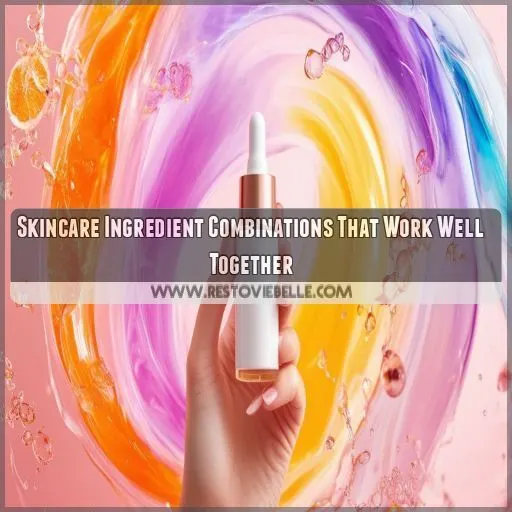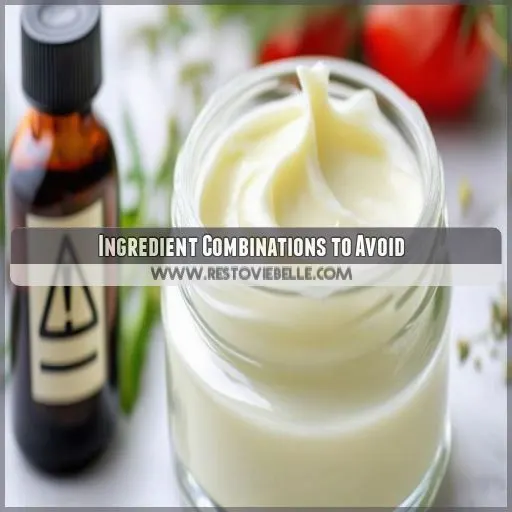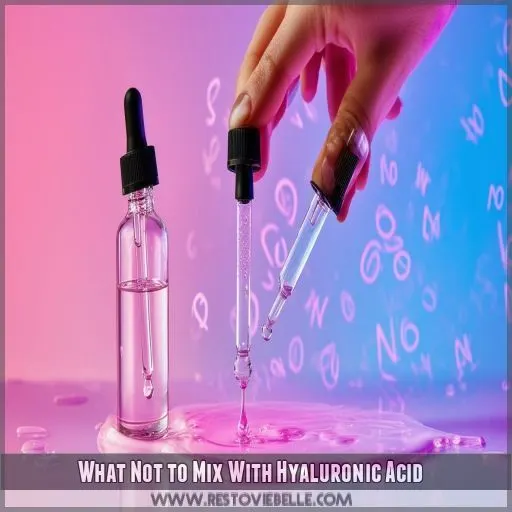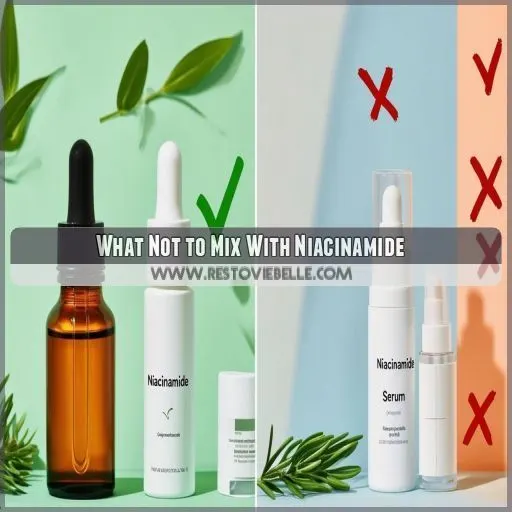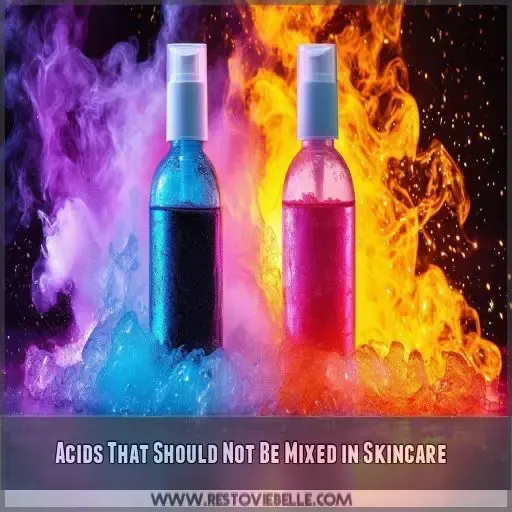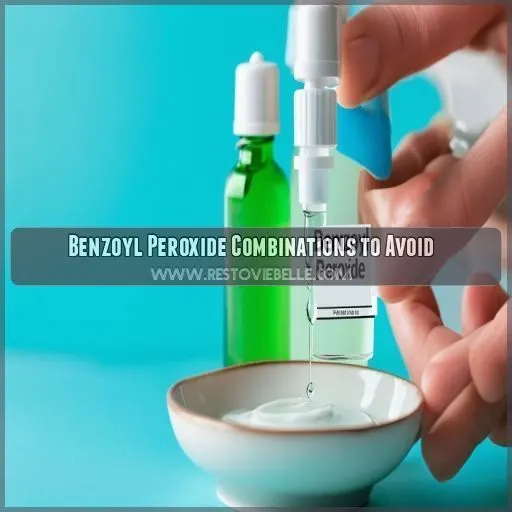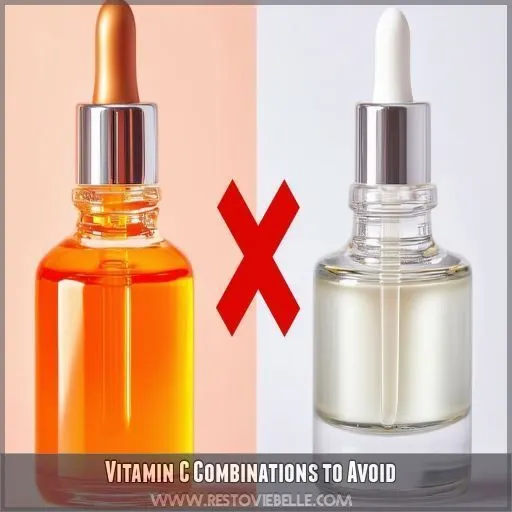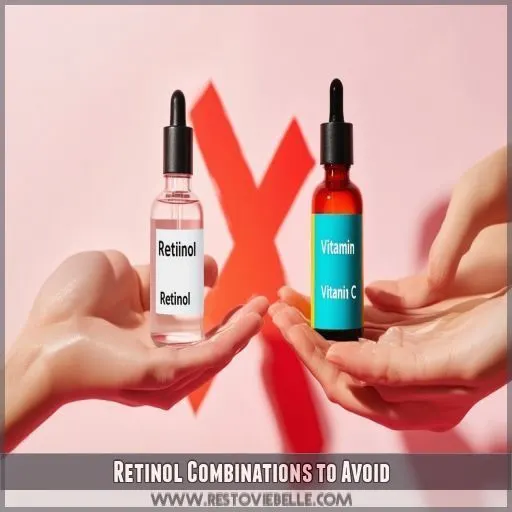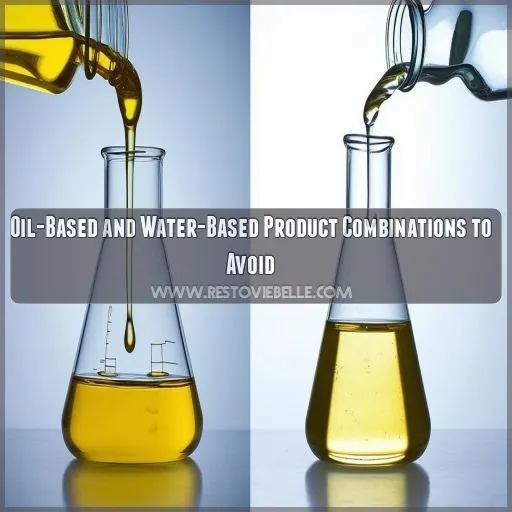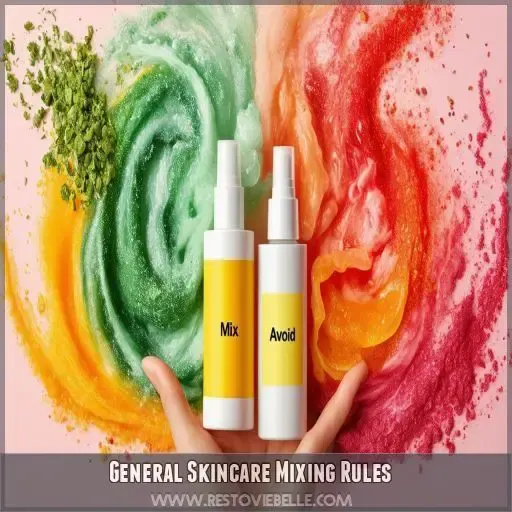This site is supported by our readers. We may earn a commission, at no cost to you, if you purchase through links.
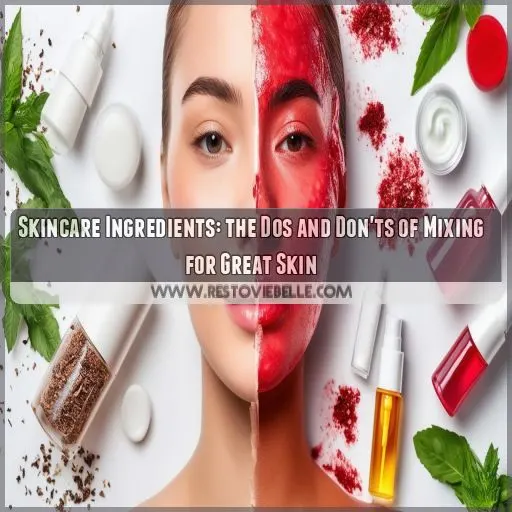
Retinols and hyaluronic acid are a match made in heaven, with the latter locking in moisture to reduce dryness from the former. Vitamin C and SPF are another dynamic duo, boosting sun protection and fighting pigmentation.
But it’s not all rainbows and smooth skin. Steer clear of mixing vitamin C with AHAs/BHAs—it’s a recipe for irritation. And don’t get too cosy with retinols and AHAs/BHAs either, as they can leave your skin dry and unhappy.
There’s more to uncover about the skincare dos and don’ts, so read on to become a mix master.
Table Of Contents
- Key Takeaways
- Skincare Ingredient Combinations That Work Well Together
- Ingredient Combinations to Avoid
- What Not to Mix With Hyaluronic Acid
- What Not to Mix With Niacinamide
- Acids That Should Not Be Mixed in Skincare
- Benzoyl Peroxide Combinations to Avoid
- Vitamin C Combinations to Avoid
- Retinol Combinations to Avoid
- Oil-Based and Water-Based Product Combinations to Avoid
- General Skincare Mixing Rules
- Frequently Asked Questions (FAQs)
- What skincare products can and Cannot be used together?
- What can’t you mix with hyaluronic acid?
- What should you not mix with niacinamide?
- Which acids should not be mixed in skincare?
- What are the benefits of combining antioxidants and SPF?
- Can I use retinol and vitamin C together?
- What happens when you mix hyaluronic acid and niacinamide?
- Is it okay to use AHA/BHA and retinol at the same time?
- Can I combine benzoyl peroxide with other acne treatments?
- Conclusion
Key Takeaways
- Some skincare ingredients are a match made in heaven, boosting each other’s effectiveness. Retinols and hyaluronic acid, for instance, are BFFs that improve skin texture and hydration. Vitamin C and SPF are another dynamic duo, creating a powerful shield against sun damage and pigmentation.
- On the other hand, certain ingredients should never share the same shelf. Vitamin C and AHAs/BHAs are like oil and water – mixing them can lead to irritation and redness. Retinols and AHAs/BHAs can also be a recipe for disaster, causing excessive dryness and unhappy skin.
- Niacinamide and hyaluronic acid are a dream team, reducing inflammation, minimizing pores, and providing a burst of hydration. This combo is a sure way to achieve a radiant, even complexion.
- Knowing your skin type is crucial before experimenting with different products. Sensitive skin requires a delicate balance between calming and irritating ingredients, while oily skin calls for a careful selection of ingredients to avoid overloading pores.
Skincare Ingredient Combinations That Work Well Together
Some skincare ingredients are like two peas in a pod, working in harmony to give your skin a one-two punch of awesome. But how do you know which ingredients play well together and which ones should steer clear of each other?
Let’s explore skincare synergy and discover some dynamic duos that will take your skincare game to the next level.
Retinols and Hyaluronic Acid
Retinol and hyaluronic acid are skincare BFFs. Hyaluronic acid attracts and locks in moisture, enhancing the anti-aging benefits of retinol. This dynamic duo improves skin texture and reduces the potential dryness that can come with retinol usage. Use them together in your nighttime routine for a one-two punch of hydration and collagen-boosting goodness. Your skin will thank you for it!
Vitamin C and SPF
Vitamin C and SPF are a powerful team when it comes to protecting your skin from the sun’s damaging rays. Here’s the scoop:
- Vitamin C boosts your SPF’s protection, creating a powerful shield against UV damage.
- It also amps up your skin’s antioxidant defenses, helping to prevent sun-induced pigmentation and premature aging.
- To get the most out of this combo, apply your Vitamin C serum in the morning, then follow up with a broad-spectrum SPF of 30 or higher.
AHAs and BHAs
AHAs (alpha-hydroxy acids) and BHAs (beta-hydroxy acids) are a powerful team when it comes to exfoliation. AHAs, like glycolic and lactic acid, work on the surface of your skin, sloughing off dead skin cells and revealing a brighter complexion. BHAs, such as salicylic acid, go deeper into your pores, clearing out the gunk that can cause breakouts. Using them together gives you a powerful exfoliation routine.
Just remember, exfoliation can be intense, so always follow up with a good moisturizer to keep your skin happy and hydrated.
Niacinamide and Hyaluronic Acid
Niacinamide and hyaluronic acid are a match made in skincare heaven.
Niacinamide reduces inflammation and minimizes pores, while hyaluronic acid provides a burst of hydration and helps your skin retain moisture.
Both ingredients are water-based and compatible, so they work together to improve skin tone and texture.
Keep an eye out for products with this dynamic duo for a radiant, even complexion.
Emollients and Humectants
Emollients and humectants are a match made in skincare heaven.
Emollients soften and smooth your skin, while humectants attract and lock in moisture.
Together, they’re a dynamic duo that provides deep hydration and helps strengthen your skin’s barrier function.
Think of emollients as the smooth operators that give your skin a much-needed drink, while humectants seal the deal by locking in that moisture.
This power couple is often found in moisturisers and creams designed to tackle dry skin issues.
So, go ahead and treat your skin to some serious hydration by using products that combine these two ingredient types.
Your skin will thank you for it!
Ingredient Combinations to Avoid
While combining certain skincare ingredients can boost their benefits, there are some combos that can cause more harm than good. Knowing which ingredients clash will help you avoid irritation, redness, and other skin troubles.
Vitamin C and AHAs/BHAs
Vitamin C and AHAs/BHAs are like oil and water—they just don’t mix. Both are acidic, so combining them can mess with their pH levels, leading to irritation and redness. It’s like pouring vinegar and baking soda together—you don’t want that volcano on your face. Keep these ingredients separate in your skincare routine to avoid a skin eruption.
Retinols and AHAs/BHAs
Retinols and AHAs/BHAs are like two feisty siblings—powerful on their own, but together, they can get a little too intense.
Both increase skin cell turnover, and using them together can lead to excessive dryness and irritation.
So, it’s best to keep them apart, especially if you’re new to these ingredients.
Alternate days or times of day to avoid any skincare drama.
Benzoyl Peroxide and Tretinoin
While both benzoyl peroxide and tretinoin are effective acne treatments, combining them can do more harm than good. Here’s why you should avoid mixing these two ingredients:
- Increased Skin Sensitivity: Both ingredients can make your skin more sensitive, and using them together may lead to irritation and redness, especially if you have sensitive skin.
- Reduced Efficacy: Benzoyl peroxide can deactivate tretinoin, reducing the effectiveness of your acne treatment.
- Potential Dryness: Both ingredients can be drying, and combining them may result in excessive dryness, leaving your skin feeling tight and uncomfortable.
- Dermatologist’s Advice: Before using these ingredients together, consult a dermatologist. They can provide personalized advice and help you navigate potential side effects.
SPF and Makeup
When it comes to SPF and makeup, there’s a simple rule to follow: keep them separate. Mixing SPF with your foundation or other base products can dilute the sun protection and leave you vulnerable to UV damage.
Here’s a quick overview:
| Combination | Action | Why |
|---|---|---|
| SPF + Makeup | Apply separately | Diluting SPF reduces protection |
Fragrances and Sensitive Skin
If you have sensitive skin, fragrances can be a common irritant. Here are some tips to keep that beautiful face of yours happy and healthy:
- Choose fragrance-free products or those with natural essential oils to reduce the risk of irritation.
- Always patch test new products on a small area of skin before applying them to your entire face.
- Consult a dermatologist if you experience any reactions or irritation. They’re the experts, and they can recommend alternatives or provide guidance on managing sensitive skin.
- When using fragrances with sensitive skin, less is more. Be cautious when trying new products, and remember that a little goes a long way.
What Not to Mix With Hyaluronic Acid
Hyaluronic acid is a skincare superstar, but even superheroes have their kryptonite. Knowing what not to mix with hyaluronic acid is important to avoid skincare mishaps and maximize its benefits.
Some ingredients don’t play well with hyaluronic acid, and mixing them can lead to less-than-stellar results. Let’s take a closer look at the don’ts of mixing with this hydration hero.
Incompatible Ingredients
Hyaluronic acid is a popular humectant, attracting and retaining moisture for plumper, more supple skin. However, there are a few ingredients you should avoid mixing with hyaluronic acid to get the best results and avoid potential skin irritation. Here’s a quick overview:
| Ingredient | Potential Issue |
|---|---|
| Vitamin C | Both ingredients are acidic and can cause pH imbalance, leading to irritation. |
| Retinol | This combination may increase skin dryness and sensitivity. |
| Soap-based cleansers | The high pH of soap-based cleansers can reduce hyaluronic acid’s absorption and effectiveness. |
PH Level Considerations
When you’re mixing skincare ingredients, it’s important to think about pH levels to keep your skin healthy.
Hyaluronic acid, a powerful humectant, can be sensitive to really acidic ingredients.
Avoid Vitamin C, AHAs, and BHAs as these ingredients can mess with your skin’s pH balance, leading to irritation and sensitivity.
Keep your skin happy by using these ingredients separately or on different days.
Moisturizer Formulations
When picking a moisturizer to use with hyaluronic acid, there are a few things to keep in mind. Here’s what you should know:
- Oil-based moisturizers: While hyaluronic acid plays well with most water-based products, it may not mix well with oil-based moisturizers. Oil-based formulas can interfere with absorption and effectiveness, so it’s best to avoid mixing them.
- Heavy, occlusive creams: Hyaluronic acid is lightweight, so pairing it with heavy creams may not be ideal. Opt for lighter, water-based moisturizers that won’t weigh down your skin.
- Moisturizers with strong actives: If your moisturizer contains actives like retinol or AHAs, consider using them at alternate times. These ingredients can be drying, and combining them with hyaluronic acid may not yield the best results.
- Fragranced moisturizers: Fragrances can irritate sensitive skin. To minimize irritation, choose fragrance-free moisturizers to pair with hyaluronic acid.
What Not to Mix With Niacinamide
Niacinamide is a skincare all-star, but it’s not a team player with certain ingredients. Acidic ingredients like AHAs and BHAs can clash with niacinamide, disrupting their pH levels and causing irritation. Steer clear of mixing niacinamide with other actives like retinoids and vitamin C, as this can decrease their effectiveness.
Acidic Ingredients
With skincare, it’s not just about what you put on your face, but also what you don’t. Niacinamide, a skin-brightening agent, plays well with most ingredients, but there’s one type you should keep it away from: acidic ingredients.
Why? Well, these acidic ingredients can mess with niacinamide’s pH levels, making it less effective and potentially irritating your skin. So, it’s a hard pass on mixing niacinamide with ingredients like AHAs and BHAs.
Incompatible Actives
Niacinamide is a versatile active ingredient that plays well with many others. However, there are a few actives you should avoid mixing with it so they stay effective and don’t cause any skin irritation. Here’s what not to mix:
- Vitamin C (ascorbic acid): While both ingredients offer brightening benefits, this combination can cause a harmless, temporary redness known as "niacin flush."
- Retinoids (like retinol): These two actives have different pH levels and may cancel each other out, reducing their individual effectiveness.
- AHAs/BHAs: Mixing niacinamide with these exfoliating acids can disrupt the pH levels, leading to potential irritation and reduced efficacy.
Acids That Should Not Be Mixed in Skincare
Some acids can be a real pain when mixing them with other skincare ingredients. The wrong combo can mess with your skin’s pH levels, leaving you with irritation and redness instead of that glow-up you were after.
So, before you go all mad scientist with your skincare routine, let’s talk about which acids to keep separate and why.
Retinols and Acids
Mixing retinols and acids can lead to some skincare concerns. Here are some acids that shouldn’t be mixed with retinols:
- Alpha Hydroxy Acids (AHAs)
- Beta Hydroxy Acids (BHAs)
- Vitamin C
- Salicylic Acid
These combinations can cause skin irritation, redness, and excessive dryness. It’s best to use these ingredients separately or consult a dermatologist for personalized advice.
Vitamin C and Acids
Vitamin C is an effective skincare ingredient, but it’s sensitive to pH levels.
It works well with some acids, like glycolic acid and ferulic acid, but not with others.
For example, pairing Vitamin C with AHAs or BHAs can destabilize its pH balance, leading to irritation and redness.
To avoid this, use Vitamin C and acidic ingredients at different times of the day or on alternate days.
Benzoyl Peroxide Combinations to Avoid
Benzoyl peroxide is a powerful acne-fighting ingredient, but it’s not always skincare’s best team player. We’ll explore the ingredients it doesn’t play well with, so you can avoid irritating your skin.
Retinols and Benzoyl Peroxide
Benzoyl peroxide and retinol are a no-go. Benzoyl peroxide can deactivate retinol, reducing its effectiveness. If anti-aging is your priority, retinol’s your go-to. But if acne’s your main concern, benzoyl peroxide takes the lead.
Hydroquinone and Benzoyl Peroxide
Hydroquinone, a skin-lightening agent, and benzoyl peroxide, an acne-fighting ingredient, are a no-go. When combined, they can cause a negative reaction, leading to skin irritation and redness.
Here’s a quick list of other benzoyl peroxide combinations to avoid:
- Retinols
- Hydroquinone
- Certain antioxidants
- Vitamin C
- Other acne treatments
Other Incompatible Ingredients
While benzoyl peroxide and tretinoin are the most well-known combinations to avoid with benzoyl peroxide, there are other ingredients you should be cautious about mixing with this powerful acne-fighter.
Here’s a table with some additional benzoyl peroxide combinations to approach with caution:
| Benzoyl Peroxide | Ingredient | Potential Issue |
|---|---|---|
| Benzoyl Peroxide | Adapalene | Irritation, dryness |
| Benzoyl Peroxide | Clindamycin | Reduced effectiveness |
| Benzoyl Peroxide | Erythromycin | Skin peeling, redness |
| Benzoyl Peroxide | Sodium Hyaluronate | Skin flaking |
| Benzoyl Peroxide | Sulfur | Skin irritation |
Vitamin C Combinations to Avoid
While Vitamin C is a skincare superstar, it doesn’t play well with everyone. Some combinations can cause more harm than good, leaving you with irritated skin instead of a radiant glow. So, before you mix and match, let’s explore the dos and don’ts of Vitamin C pairings to make sure your skin stays happy and healthy.
AHAs and Vitamin C
As a skincare ingredient aficionado, you know that some ingredients, like AHAs and Vitamin C, can be a tricky duo. Here’s why you should avoid mixing them:
- Both are acidic powerhouses, but their pH levels don’t play well together.
- Mixing them can destabilize each other’s pH balance, leading to skincare troubles.
- The result? Irritation, redness, and sensitivity may crash your skincare party.
- So, keep them apart and use them on alternate days or at different times of the day to avoid any skincare drama.
Retinols and Vitamin C
Retinol and vitamin C are a tricky duo.
While retinol works wonders at night, vitamin C shines during the day.
Vitamin C is most effective in an acidic environment, but retinol prefers a higher, more alkaline pH.
Combining them may reduce their benefits.
So, what’s the solution?
Use retinol at night and vitamin C in the morning.
This way, you get the best of both worlds without any interference.
Retinol Combinations to Avoid
Retinol is a superstar in the anti-aging skincare arena, but it’s not always a team player. Knowing which ingredients to avoid mixing with retinol is important to sidestepping irritation and redness.
Benzoyl peroxide, vitamin C, and salicylic acid are key players in your skincare routine, but they don’t always mix well with retinol. Let’s look at why these combinations are a no-go and how to navigate your skincare routine like a pro.
Benzoyl Peroxide and Retinol
Benzoyl peroxide and retinol are a no-go for your skincare routine. Benzoyl peroxide, a common acne treatment, can deactivate the retinol molecule, reducing its effectiveness. This combination can lead to increased skin irritation and redness, especially for those with sensitive skin.
Here are some key considerations for using benzoyl peroxide and retinol:
- If acne treatment is your priority, choose benzoyl peroxide over retinol.
- While retinol is great for anti-aging, its benefits may be compromised when paired with benzoyl peroxide.
- Consult a dermatologist before using these ingredients together to avoid potential skin irritation.
- Consider using these ingredients on alternate days or at different times to minimize adverse effects.
Vitamin C and Retinol
Vitamin C and retinol are both skincare powerhouses, but combining them can be tricky.
Vitamin C is most effective in an acidic environment, while retinol works best at a higher, more alkaline pH level.
Using them together may reduce their individual effectiveness.
The solution? Keep these two ingredients separate by applying vitamin C in the morning and retinol at night.
This way, you’ll get the benefits of both without any interference.
Salicylic Acid and Retinol
Salicylic acid and retinol are a no-go for skincare routines. Both ingredients can be drying, and using them together may lead to irritation and increased oil production. Avoid this combination to keep your skin happy and healthy. Instead, opt for a hydrating moisturizer to balance things out.
Oil-Based and Water-Based Product Combinations to Avoid
Oil and water don’t mix—literally. You don’t want to end up with a greasy mess or a watered-down concoction. So, when it comes to your skincare routine, knowing which products to combine is key.
You’ll want to avoid certain oil-based and water-based product combinations to get the most out of your skincare and avoid any potential skin issues.
Incompatible Formulations
Incompatible formulations are a major skincare no-no.
Oil-based and water-based products don’t always play nicely together, leading to skin reactions and reduced effectiveness.
Avoid mixing oil-based cleansers with water-based treatments like toners or essences.
This can create a mess and hinder absorption.
Also, steer clear of combining oil-based serums with water-based moisturisers, as they may clash and leave your skin feeling greasy.
Skin Type Considerations
Now, let’s talk about how your skin type influences the products you mix.
If you have dry skin, you might be tempted to slather on multiple hydrating layers. But, be cautious with oil-based and water-based products.
For sensitive skin, it’s a fine line between calming and irritating.
And if you’re battling oily skin, you don’t want to overload your pores with heavy combinations.
Finding the right product mix for your skin type is a delicate balance.
General Skincare Mixing Rules
Mixing skincare products can be tricky. You don’t want to overdo it and end up with a sticky, greasy mess or, worse, irritate your skin. Here are some golden rules to keep in mind:
- Start with a small amount: A little goes a long way, especially with potent active ingredients.
- Patch test: Always do a patch test on your skin to check for any adverse reactions before applying new products to your face.
- Layer wisely: Generally, apply products from thin to thick consistency. This allows thinner products to absorb effectively without being blocked by thicker ones.
- Give it time: Wait a few minutes between applications to let each product absorb properly.
- Know your skin: Understand your skin type and concerns to choose compatible ingredients.
- Avoid over-exfoliation: Be cautious with exfoliants like AHAs and BHAs. Overdoing it can irritate and damage your skin.
- Seek expert advice: If in doubt, consult a dermatologist. They can provide personalized advice and recommendations.
Frequently Asked Questions (FAQs)
What skincare products can and Cannot be used together?
The right ingredient combos can boost your skin’s radiance. But beware—mixing the wrong ones can lead to irritation. Let’s explore the skincare combos to embrace and those to skip.
What can’t you mix with hyaluronic acid?
Hyaluronic acid works well with retinoids to combat dryness. But steer clear of retinoids with benzoyl peroxide—it’ll make the retinoid less effective.
What should you not mix with niacinamide?
You should avoid mixing niacinamide with vitamin C. This combo sparks debate—some say it’s a no-go, others say it’s a dream team. Either way, it’s a risky move that might leave both ingredients useless.
Which acids should not be mixed in skincare?
Don’t mix Vitamin C with AHAs and BHAs, like glycolic, salicylic, and lactic acids. Also, avoid combining retinol with glycolic acid.
What are the benefits of combining antioxidants and SPF?
Antioxidants and SPF are a match made in heaven. Topical antioxidants enhance the protective benefits of sunscreen, boosting your skin’s defence against sun damage and free radicals. Serums are a great way to deliver concentrated antioxidants to your skin.
Can I use retinol and vitamin C together?
Yes, you can use retinol and vitamin C together. Apply vitamin C in the morning and retinol at night to avoid interfering with their pH levels.
What happens when you mix hyaluronic acid and niacinamide?
When combined, hyaluronic acid and niacinamide work to improve skin hydration and overall appearance. They also enhance skin barrier function, improve skin firmness and elasticity, and reduce wrinkles.
Is it okay to use AHA/BHA and retinol at the same time?
It’s not recommended to use AHA/BHA and retinol together due to the risk of skin irritation and dryness. However, if your skin is resilient, you can use them together, but it’s best to leave a day between applications.
Can I combine benzoyl peroxide with other acne treatments?
Benzoyl peroxide works well with some acne treatments, like salicylic acid and topical antibiotics. Avoid mixing it with retinol or tretinoin, as they can irritate skin or deactivate each other.
Conclusion
Mixing skincare ingredients is a delicate balance—get it right, and your skin glows up; get it wrong, and irritation rears its ugly head.
You now know the skincare ingredient combinations that work like a dream, and the ones that spell disaster.
So, go ahead and experiment with different products, but always remember to do a patch test first to make sure your skin loves the mix as much as you do.
Now you can be a real mix master.

